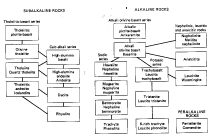 | Major and Minor Elements |
Magma series |
See http://plate-tectonic.narod.ru/petrographyigneouslinks.html
C http://ijolite.geology.uiuc.edu/08SprgClass/geo436/lectures.html
http://ijolite.geology.uiuc.edu/08SprgClass/geo436/436%20lectures/L10-Major.html
I. Chemical analysis
A. Text tells history of technological developments
-Relatively easy now to obtain whole-rock analyses = bulk chemical composition, traditionally expressed as oxides
-X-ray fluorescence, instrumental neutron activation analysis, mass spectrometry used for whole-rock analyses
-Electron microprobe used to obtain chemical composition within individual mineral grains
-Detection limit = lowest concentration that can be accurately determined
II. Variation diagrams
A. Def: graphical way of presenting data - good for recognizing trends
-No one correct way to do this
-May use either X-Y or triangular plot
B. Harker diagrams
-Various oxides plotted vs. SiO2 for Crater Lake samples - trends obvious but not perfect; lines are best-fit to data; smooth curves => genetic relationship among samples
-Terminology: primary magma = one derived from partial melting of source rock; evolved magma = one that has undergone differentiation; parental magma = least evolved from a suite
-Change in liquid composition = liquid line of descent
-Fractional crystallization considered most likely process: tests for F.C. hypothesis: trends (LLD) should ~ experimental phase diagram; more evolved samples should be younger than less evolved; harker diagrams can support a particular process such as F.C. but can''t prove it
C. AFM diagram
-Triangular plot : A = Na+K; F = total Fe; M = Mg
III. Modeling magmatic evolution
A. Pearce element ratios
-Used to test whether a particular mineral is fractionating from a liquid
B. Graphical analysis
IV. Magma series
A. Def: a group of rocks that shows smooth trends on variation diagrams, which implies a genetic relationship among them
-Three main groups - figure : Alkaline (Sodic/Potassic/Other); Subalkaline (lower in alkalis, higher in silica - commonly oversaturated = qz present)(Tholeitic/Calc-alkaline/Peralkaline )
-These seem to express some underlying physical & chemical reality about magmas.
B. The basalt tetrahedron
-Quaternary system:Ne-Di-Fo-Qz; binary compounds En and Ab
-Di-Ab-Fo triangle divides tetrahedron into two parts = critical plane of silica undersaturation: left has lower Si and foids appear, right has more Si-rich phases.
-Di-Ab-En triangle = plane of silica saturation: to the right, Q appears as a separate phase
THE CONCEPT OF IGNEOUS ROCK (MAGMA) SERIES
Tholeiitic magma series
Calc-alkaline magma series
